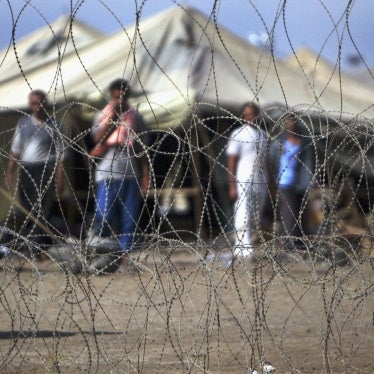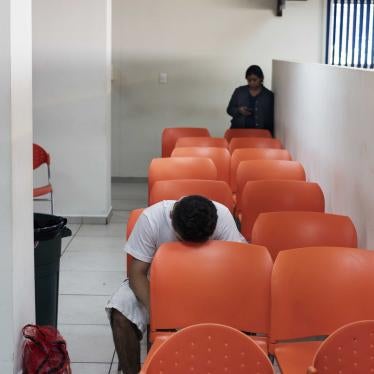The sadistic abuse and sexual humiliation by American soldiers at Abu Ghraib prison has shocked most Americans—but not those of us familiar with U.S. jails and prisons. In American prisons today, wanton staff brutality and degrading treatment of inmates occur across the country with distressing frequency.
The Pentagon has said it wants to send more people to Iraq who have U.S. prison experience. But before it does, it should look closely at the human rights records of their prisons.
A federal judge in 1999 concluded that Texas prisons were pervaded by a “culture of sadistic and malicious violence.” In 1995, a federal judge found a stunning pattern of staff assaults, abusive use of electronic stun devices guns, beatings, and brutality at Pelican Bay Prison in California, and concluded the violence “appears to be open, acknowledged, tolerated and sometimes expressly approved” by high ranking corrections officials.
In recent years, U.S. prison inmates have been beaten with fists and batons, stomped on, kicked, shot, stunned with electronic devices, doused with chemical sprays, choked, and slammed face first onto concrete floors by the officers whose job it is to guard them. Inmates have ended up with broken jaws, smashed ribs, perforated eardrums, missing teeth, burn scars—not to mention psychological scars and emotional pain. Some have died.
Both men and women prisoners—but especially women—face staff rape and sexual abuse. Correctional officers will bribe, coerce, or violently force inmates into granting sexual favors, including oral sex or intercourse. Prison staff have laughed at and ignored the pleas of male prisoners seeking protection from rape by other inmates.
Most of the men and women who work in U.S. prisons are decent professionals who have never physically abused or intentionally degraded an inmate. But just as in Iraq, the absence of leadership, oversight, and external scrutiny can create a climate in which abuses will occur.
The Department of Justice’s Inspector General recently reported on the abuse Muslim men picked up after September 11 endured while detained at the federal Metropolitan Detention Center in Brooklyn. For example, officers slammed unresisting, shackled inmates into walls and mocked them during body-cavity searches. A lawsuit by one of the detainees alleges that one of the officers maliciously pushed a pencil into his anus.
Just this January, a videotape at a California facility captured two officers beating and kicking two inmates. One officer struck an inmate approximately twenty times in the face; another officer is shown kicking a handcuffed inmate in the head.
When Florida inmate Frank Valdez died in 1999, every rib in his body was broken, his corpse bore the imprint of boot marks, and his testicles were badly swollen; guards admitted having struggled with him, but denied they had used excessive force. They claimed most of his injuries had been “self-inflicted.”
In Maricopa County, Arizona, a sheriff who dresses male jail inmates in pink underwear introduced live “jail cam” broadcasts on the internet in 2000. Three cameras covered the holding and searching cells of the jail, including shots of strip searches, inmates bound in “restraint chairs,” and even, for a while, unobstructed views of women using the toilet. The broadcasts ended up being copied onto web porn sites.
Even detained children and youth are not immune from staff brutality and abuse. They too are kicked, beaten, punched, choked, and sexually preyed upon by adult staff. The Maryland State Police recently filed criminal assault charges against staff at a youth facility in Maryland because of an incident in which one guard restrained a youth while the three others kicked him and punched him in the face. In January 2004, the U.S. Department of Justice reported on terrible conditions at Arizona’s juvenile detentions centers, including sexual abuse of the children by staff members (and fellow inmates) that occurs “with disturbing frequency” and a level of physical abuse that is ”equally disturbing.”
When the news about Abu Ghraib broke, the Bush administration tried to suggest it was the work of a few rogue officers. But in over two decades of monitoring prisons in the United States and around the world, Human Rights Watch has learned that abusive officers do not operate in a vacuum. More typically, a culture of brutality has developed in which correctional officers know they can get away with excessive, unnecessary, or even purely malicious violence. In such prisons, senior officials have failed to communicate unequivocally—through training, staff supervision, investigations, and discipline—that abuse will not be tolerated.
The failures of senior prison officials in the United States are compounded, as in Abu Ghraib, by the absence of external scrutiny. Prisons are closed institutions from which the press, human rights groups, and members of the public are typically excluded. Independent expert inspections yielding public findings are rare, and usually occur only after the situation has become so bad that inmates have filed a lawsuit.
Perhaps if photos or videotapes of abuse in U.S. prisons were to circulate publicly, Americans would be galvanized to protest such treatment as they have the treatment of Iraqi prisoners. Absent such graphic and unavoidable evidence, it is all too likely that abuse will continue to be a part of many prison sentences.






